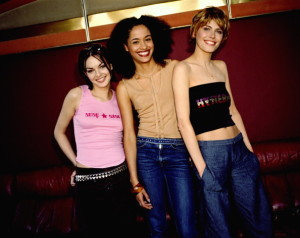As we near the advent of warmer weather I can’t help but inwardly groan as I consider that soon we will see hoards of lemmings following the fashion fads, wearing barely-there clothing that defies the definition of clothing, let alone modesty.
And so I began thinking, how did we get to the point where we thought that dressing in such a way, that we are leaving little to the imagination, was a good thing, and that dressing in a dignified way was frumpy?
What I discovered, is nothing short of interesting and thought provoking.
Fashion before 1901
‘And the LORD God made garments of skins for the man and for his wife, and clothed them.’(Gen 3:21)
After the fall, Adam and Eve needed to be clothed. Prior to the fall there was no need, they could be naked and were not ashamed because they were not drawn to sin. In other words, they could walk around the Garden of Eden naked because it would not tempt the other person to sin by say, lusting after them.
So before sin entered the world, we didn’t need clothes. Just think, if Adam and Eve had never sinned, we’d all be walking around in our birthday suits – naked and unashamed.
But they did sin, and as a result it was necessary for God to clothe them so as to try and preserve their purity. Basically, we need to wear clothes so as to respect our bodies as temples of the Holy Spirit, and to respect others by not tempting them to sin.
So then, when God clothed Adam and Eve, how did he do it? He clothed them in a tunicas – tunic. A Biblical (and pre-Christian) tunic was a flowing garment that extended past the knees and covered both arms and shoulders. If you consider any illustrated Bible, Old or New Testament, and the way that the clothing is depicted you’ll understand what I mean.
Early pagan Greek and Roman styles for women were also flowing and floor length robes and gowns or tunics that were either sleeveless or sleeved, belted at the waist and were often finished off with a veil or a hair ornament. Men wore knee length versions of these tunics or robes.
Now these basic styles did not change much for centuries and by the time of the Crusades, or Middle Ages, (c. 1096-1272) women wore elegant floor length gowns, with sleeves and married women wore a veil. In fact, even hair-styles were changed upon a change in marital status. Prior to marriage young women wore their hair loose and flowing and once wed they tied it back into a bun or similar. (This tradition was reinvented years later. Prior to coming out in society a young woman wore her hair down as a sign of her youth and when she made her debut and was considered a woman she wore her hair up).
At this time the veil worn by married women was worn over a wimple – think of cloistered nun’s habits, particularly say, St Therese of Lisieux – and a girdle was worn around the waist or hips.
By the time of Elizabethan England (late sixteenth century) fashion had become more ornate, though the basic structure remained the same. That is: long gowns, long sleeves and a head covering of some description. However they introduced collar ruffles, the corset, large sleeves and replaced the wimple with various styles of headdresses, some of which had a veil attached at the back.
The French Revolution (1789-1804) saw a fashion revolution as well. Napoleon Bonaparte’s wife, Josephine, started a trend of high waisted, straight dresses with flattened bust lines which we would today recognise as being the ‘Jane Austen’ look of high waists, low cut bodices, a long and straight skirt and long and narrow sleeves or short and puffy ones or even a combination of both. At this time in the young United States of America came the ‘Civil War’ style with a natural waist, very full skirts with hoops and petticoats (think Scarlett O’Hara), followed by the bustle.
At the advent of the Twentieth Century fashion, though different in look, was still the same in principle and in that sense had really changed little since Biblical times. But the Twentieth Century would deliver a radical change in fashion styles.
Fashion since 1901
The fashions of the early Twentieth Century were characterised by wide shoulders and tiny waists. Hemlines moved up a few inches above the ankle, which to us today seems like very little, but at the time, showing your ankle was considered to be immodest.
Yet by the ‘Roaring Twenties’ only a decade or so later, women sported short hair-styles and flapper styles which had boyish silhouettes, knee length skirts and sleeveless bodices were introduced as well. This boyish and masculine way of dressing was thanks largely to Coco Chanel. At this time Yves Saint Laurent introduced pant suits for women but the idea did not take off at the time and swim suits designs were changing.
During World War II (1939-1945) women in America wore overalls and pants to work in the factories, but once off duty they returned to a more feminine way of dressing – skirts and dresses – and took pains to set their curls.
In 1946 the bikini was introduced and Louis Reard, who was responsible for its design, could not persuade any fashion models to wear it as they considered it too immodest, and hired Michele Bernardini, a nude dancer, to model it for him. The bikini was banned in Catholic countries such as Spain and Italy, yet today it is a staple in many women’s wardrobes.
About this time, Christian Dior reintroduced design elements that were feminine such as long flared skirts and belted waists but Coco Chanel was back in a big way and reacting against such designs, opting instead for more masculine designs including bell bottom pants which planted the seed for women to wear pants. Influential Hollywood actresses like Audrey Hepburn wore her designs and so fashion changed from the feminine ideal of Marilyn Monroe (1950s) to something more boyish like Twiggy (1960s).
The sixties also saw hemlines shoot up with the sexual revolution and sexuality became a way of dressing. Femininity and its identifying fashion items, like the girdle, were thrown out the window. By the 1970s women were working more and more outside the home and pants were really popular. Jeans became a symbol of revolution (feminism) and though long skirts were reintroduced, they were rejected by the mainstream.
The 80s and 90s saw more casual dressing and fashion innovations such as shoulder pads, huge accessories and the coining of the phrase ‘business casual’. By the end of Twentieth, and the beginning of the Twenty-first, Century ideas of femininity and modesty had been completely rejected by mainstream and dressing for sexuality the name of the game.
First published in ave maria
Originally posted 2015-11-05 03:22:20.



Wow this is a great article Emily! A wonderfully written piece dealing with an often contentious subject. Thank you!